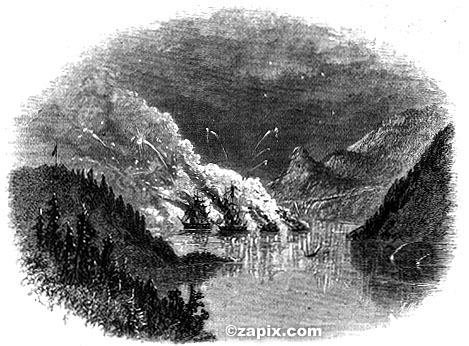|
|
The Romance of the Hudson, Part I, continued
big, hissing hot, into the water, killed a sturgeon. The sailors got the dead monster of the deep on board. It was cooked. When Stuyvesant ate of the fish and heard the strange story of its death, he "marveled exceedingly;" and in commemoration of the event be named the lofty hill, which rises more than twelve hundred feet above the bosom of the river, "Anthony's Nose."
As the steamboat sweeps around the Donder Berg, with Anthony's Nose on the right, the theatre of one of the most interesting of the romances of the Hudson is presented in lofty Bear Mountain in front, Lake Sinnipink, or Bloody Pond, on a broad terrace at its base, and Poplopens Creek flowing into the river on the western shore between high rocky banks. Upon these banks lay Forts Clinton and Montgomery, the former on the south side of the creek and the latter on the north side. These forts were built by the Americans for the defense of the lower entrance to the Highlands against fleets of the enemy that might ascend the river, for it was known that from the beginning that it was a capital plan of the British ministry to get possession of the valley of the Hudson, and so separate New England from the other colonies. In addition to these forts, a boom and chain were stretched across the river from Fort Montgomery to Anthony's Nose to obstruct the navigation. We have observed that Clinton swept around the Donder Berg with a part of his army, and fell upon Forts Clinton and Montgomery. That was on the 7th of October 1777. The brothers Generals George (Gov. Clinton commanded the little garrisons. They were brave and vigilant. It was not an easy task for the enemy to approach the fort through the rugged mountain passes, watched and attacked by scouting parties. They had divided, one party, accompanied by the baronet, making their way toward evening between Lake Sinnipink and the river. There they encountered abatis covering a detachment of Americans. A severe fight ensued. The dead were thrown into the lake, and it was called Bloody Pond. Both divisions now pressed toward the forts, closely invested them, and were supported by a heavy cannonade from the British flotilla. The battle raged until twilight. Overwhelming numbers of the assailants caused the Americans to abandon their works under cover of darkness and flee to the mountains. Before leaving, they set fire to two frigates, two armed galleys, and a sloop, which had been placed above the boom. That conflagration was magnificent. The sails of the vessels were all set, and they soon became splendid pyramids of flame. Over the bosom of the river was spread a broad sheet of ruddy light for a great distance, and the surrounding mountains were brilliantly illuminated by the fire, which gave aid to the fugitives among the dreary hills. These features of the event, with the booming of the loaded cannon on the burning vessels when the fire reached them, answered by echoes from a hundred hills, produced a scene of awful grandeur witnessed before nor since on the borders of the Hudson. It was a wild and fearful romance, that ended in the breaking of the boom and chain, and the passage up the river of a British squadron with marauding troops. These laid in ashes many a fair never mansion belonging to republicans as far north as Livingston's Manor, on the lower verge of Columbia County.  Burning the Ships.
|
|
Page 17
—End of Article— Books & articles appearing here are modified adaptations
from a private collection of vintage books & magazines. Reproduction of these pages is prohibited without written permission. © Laurel O'Donnell, 1996-2006.
|
|


